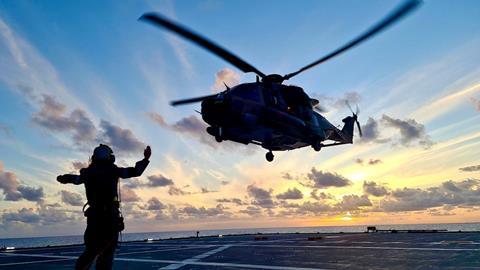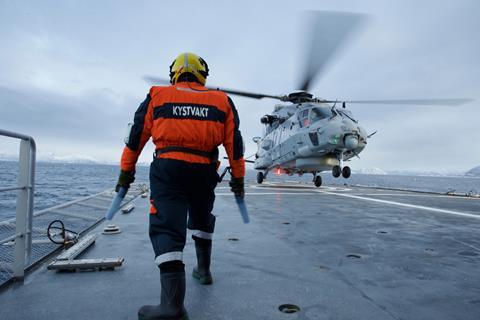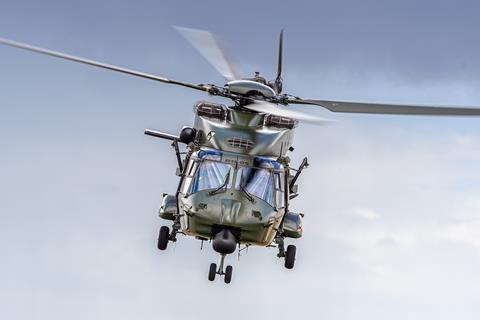Availability rates as low as 25% on the NH Industries (NHI) NH90 were the result of too much focus on managing the acquisition and introduction of the helicopters and not enough on how to keep them flying, according to a senior Airbus Helicopters executive.
The 11t rotorcraft has come in for regular criticism from several customers due to inoperable aircraft, long wait times for spare parts or maintenance, and lengthy retrofit periods; Australia in particular has become so frustrated with the NH90’s problems that it seems almost certain to ditch its fleet in favour of the Sikorsky UH-60M Black Hawk.

“In the past the focus was on contract management,” says Christoph Zammert, executive vice-president of customer support and services at the airframer, which is a partner in NHI alongside Leonardo Helicopters and Fokker.
“The contractual set ups were not always putting enough focus and priority on flight availability. We have now realised this and we are moving towards a more collaborative approach [with customers].”
In part, that is due to the maturity of the programme, enabling a move to the “sustainment phase”, whereas previously “it was very much focused on managing the acquisition and industrial delivery of the fleet to the customers”.
However, that shift in mindset at the industrial and customer level “could have been done earlier”, admits Zammert.
Across the whole fleet – which encompasses 14 operators flying a mix of the naval NFH and TTH troop transport variants – availability rates average 40%, he says, with the manufacturer aiming to reach at least 50% by 2023, a level that “should be possible”, he says.
Zammert reveals that the lowest recorded availability rate was 25%; this was at a customer two or three years ago and was “mainly driven by the introduction of a new type in a support environment that was used to other OEMs’ models and needed to manage the transition to the NH90 generation”.
Although the NH90’s availability is frequently compared with that of the stock Black Hawk, Zammert argues that its performance is better benchmarked against helicopters where extensive mission equipment “adds complexity and generates additional maintenance workload”.
“You would see similar availability figures comparing the NFH to the Romeo or the TTH to the M-model Black Hawk,” he asserts.

Airbus Helicopters has also invested in centrally held spare parts “rather than wait for the customer to do so”, which “past experience shows is not the best way of doing things”.
In addition, NHI and its partner companies have been working more closely with individual customers to tackle specific issues, and to share best practice across the operator community, says Nathalie Tarnaud Laude, senior vice-president and head of the NH90 programme at Airbus Helicopters and president of NHI.
She argues that a “transformation plan” launched last year and featuring 22 separate initiatives, is having a tangible impact on fleet availability. That has included the extension of maintenance intervals for certain tasks, plus the establishment of local partnerships for repair and overhaul work, such as with Kongsberg in Norway.
That deal appears crucial to NHI’s overall recovery plan in the Nordic country: frustrated with the slow pace of deliveries and low aircraft availability, Oslo in February again threatened to walk away from the programme if there was no improvement.
“We consider that developing a relationship with partners in Norway is very important. Considering the situation with Norway at the moment, where aircraft are not flying enough, we believe such partnerships can really make a big step-change,” she says.
Oslo laid out its concerns in a letter to NHI and Tarnaud Laude says the issues raised have been answered “with very clear solutions – we now believe we have a plan to improve the situation for them”.

Availability issues should ease further as the fleet grows: Norway’s final serial NH90 is due to be delivered shortly, followed by its final retrofitted helicopter by the end of 2023, she says.
The time taken to perform retrofits – a requirement due to early aircraft being delivered in an initial operating capability standard – has been another bone of contention with operators. That process is being accelerated, she says: there are 107 NH90s still awaiting retrofit and NHI has so far this year delivered five of the 20 upgraded units scheduled. That compares with 13 in 2021 and five in 2020, and illustrates “quite significant levels of ramp-up”, she says.
While mission systems are still awaited for “a couple” of helicopters awaiting retrofit, overall “we feel confident we can accelerate retrofit deliveries in 2022 as scheduled”, says Tarnaud Laude.
But even with the improvements being made they seem unlikely to be enough to rescue the situation in Australia, which in late 2021 said it would retire its MRH90s – the local designation for the NH90 – to be replaced by UH-60Ms.
Although no final decision will be made until the end of the year – and a change of government may alter the picture – Canberra seems set on divesting the NH90; indeed, it has already phased out five examples used by the Royal Australian Navy in favour of additional MH-60Rs.
Tarnaud Laude still holds out some hope that the NH90 can find a way back, but counsels that “we should not be naive” about its prospects. However, with the remaining 42 helicopters likely to continue in operation until 2026 or 2027, future support will remain necessary; both sides are discussing an extension to the current contract, she says.

“It is very important for us that no matter what the decision is that we deliver on our commitments [so] that the customer can fly when they want.” NHI is has promised that 38 units will be available by mid-2022.
Meanwhile, development of the new Standard 2 configuration for the French special forces continues, with the critical design review milestone imminent: “Here we are on a very good track,” says Tarnaud Laude. Deliveries are due to begin in 2025.
In addition, a separate major system upgrade called SWR3 is currently being discussed with the NATO NAHEMA helicopter management agency and NH90 operators. This could require considerable downtime to perform the upgrade on each helicopter, Tarnaud Laude admits. She remains hopeful this can be reduced to 12 months, “but we are not there yet”.
Meanwhile, NHI is hopeful that it will receive a contract from NAHEMA in the coming weeks to conduct an analysis that will allow the lifetime of the NH90 to be extended to 50 years.
“This is something that was positively appreciated by the customers who want to continue to operate the aircraft of course beyond 2030 and until at least 2050,” she says.
But with the backlog dwindling, production is currently set to run out in about 2026. However, Tarnaud Laude thinks more NH90s can be sold.
“To be honest with you we totally believe we can accept other customers,” she says. “We have a good machine – we are convinced that it is one of the best machines in the category – we just need to convince them it can be operated with better availability.”


























